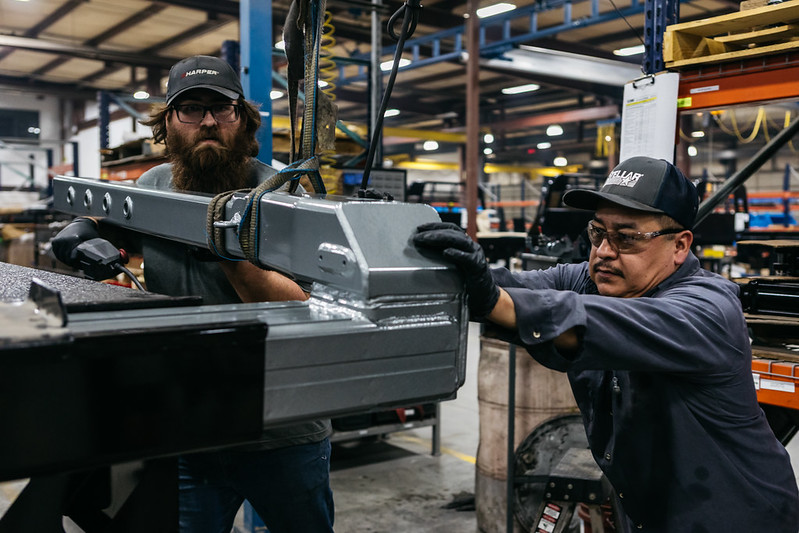The U.S. Department of Labor’s Workforce Innovation and Opportunity Act (WIOA) is designed to:
- Strengthen and improve the nation’s public workforce system
- Help get Americans – including youth and those with significant barriers to employment – into high-quality jobs and careers
- Help employers hire and retain skilled workers
Signed into law on July 22, 2014, it is the primary federal legislation for increased coordination among federal workforce development programs and related programs.
The problem with WIOA, according to Keith Lawing, president and chief executive officer of the Workforce Alliance of South Central Kansas, is that “it is very confusing,” because there is a wide array of programs administered by different federal and state agencies.
Local Workforce Development Boards, which are in every state, can “be a great assistance, because they are there to help employers navigate the bureaucratic maze of WIOA to get them to the services that they need the most.”
Headquartered in Wichita, KS, the Workforce Alliance of South Central Kansas is a local Workforce Development Board (WDB). It’s the local administrative entity and program coordinator for the WIOA. Lawing discussed the workings of local WDBs with attendees of AEM’s recently held Workforce Solutions Virtual Summit.
For more support, ideas, or information related to diversity and inclusion, get started by visiting the AEM Workforce Solutions Toolkit. To access to the full presentation from The Workforce Alliance of South Central Kansas, check it out on demand.
A WDB is a formal group of community leaders serving a city, county or a region that identifies the needs of a local job market, oversees one-stop career centers and works to coordinate and align workforce development initiatives in its area, he explained. Membership is made up of businesses, local elected officials, labor, economic development, educators and community leaders.
Workforce development programs provide a combination of education and training services and may include activities such as job search assistance, career counseling, occupational skill training, classroom training and on-the-job training, added Lawing.
Foremost Focus
For WDBs, the primary focus is on WIOA Title 1, said Lawing. This encompasses three primary funding streams managed directly by the local WDB:
- Adult – Basically for low-skilled adults that require training and employment services necessary to be successful in the workplace
- Dislocated worker – Individuals who have been laid off
- Youth, ages 14 to 24 – Essentially for helping young people overcome barriers to employment, specifically out of school, pregnant, parenting, foster care, juvenile justice and disabilities
He explained that local WDBs:
- Are demand driven
- Have local control of the federal money that comes through state agencies
- Are employer led. The majority of WDBs must be from the business community, especially decision makers. There is also representation from the workforce and other partners within the system, including adult education, vocational rehabilitation, local education and training providers and economic and community development
- Are a place of universal access, serving both job seekers and employers, and they manage the alignment and coordination of employment and training services and programs.
Three Primary Tasks
Workforce Development Boards have three main roles and responsibilities, noted Lawing:
- Strategic functions – Developing local plans; conducting workforce research and regional labor market analysis; negotiating performance measures; developing budgets for local activities; and leading career pathway development.
- System capacity building – Identifying and promoting promising practices to meet the needs of employers and workers with disabilities; convening, brokering and leveraging local stakeholders to assist in writing plans and identifying non-federal expertise and resources; and engaging a diverse range of employers to promote business representation and industry/sector partnerships.
- Systems alignment and effective operations – Identifying eligible training providers; designing one-stop operators; program oversight and developing memorandum of understandings with one-stop partners; conducting oversight of local youth activities; and identifying eligible youth providers and awarding competitive grants/contracts.
"Local Workforce Development Boards, which are in every state, can be a great assistance, because they are there to help employers navigate the bureaucratic maze of WIOA to get them to the services that they need the most,” --Keith Lawing, president and chief executive officer of the Workforce Alliance of South Central Kansas
Creating Community Impact
From his 15-plus years of experience with Workforce Development Boards, Lawing observed that the “most effective ones look at the WIOA as the floor of operations, not the ceiling. They are not there just to administer one single piece of federal legislation, but rather leverage WIOA funds and align services with community partners to create a visible community impact and try and adapt to whatever the local priorities are.”
By way of example, he said summer youth employment has been a major challenge in South Central Kansas as the number of youths working has declined “tremendously” over the years.
“We felt kids were losing an opportunity around career awareness and learning soft skills like how to show up on a job on time, taking direction for a supervisor and working with others. We created an intentional opportunity to find a first job or internship for youths over a summer. That was a need and we stepped into that space.”
Lawing cited another need in the area. “There are a high number of ex-offenders leaving the justice system and reintegrating into society and they need employment assistance. The Workforce Alliance of South Central Kansas has developed programs to help these individuals find jobs and hopefully keep them from re-offending.”
A Connection to Resources
There are many services employers can access from their local Workforce Development Boards, said Lawing.
“Because many local, state and federal organizations help provide valuable services, most services are available free of charge,” he added.
Among these services:
- Job postings. Help with job postings on state job boards at no cost. Additionally, people who come into WDB job centers register. If they are applying for jobs, it will link to an employer’s job posting if they have a skill match.
- Centralized locations to accept job applications. Some companies do not want to use their name in job posting, he noted. Others will use the company name but want applicants to go through a job center to apply. Job centers can screen applicants, which helps a company’s HR department.
- Referral of qualified candidates. Local WDBs fund training and can refer a person in a training program to a job that they are qualified for.
- Host or coordinate job fairs.
- Provide interviewing facilities for those companies that do not want job applicants coming onsite. Also provide space for training and meetings.
- Pre-employment skills assessments and testing.
- Labor market information, such as wages, hiring data, trends and other information that is moving the job market.
- Social media promotion. Because good WDBs are up on social media tools and on the different ways job seekers are communicating today, they can help a company amplify its job postings and employment opportunities, said Lawing.
- Assistance accessing training funds for on-the-job training for new hires, incumbent working training and Registered Apprenticeship Programs.
Training Programs
“Your local WDB can help you with skills training needs in a number of different ways,” Lawing pointed out. “Because we know through relationships with our community and technical colleges when people are graduating and what training programs they are, we can help connect employers to access talent.”
Another strategy that “is working very effectively is that we guarantee interviews for individuals in certain training programs. Often, if someone is thinking about a training program and they know that when they finish that training there is an employer willing to interview them for a job, the more likely they are to get into and complete that program.”
There are also opportunities to help fund on-the-job training programs for new hires, added Lawing. If an employer has someone it wants to bring onboard and the person doesn’t have the skill set required and needs some on-the-job training, there are funds available to help with the training costs.
He encouraged employers to engage with their local Workforce Development Boards for incumbent worker training. For those companies that have career pathways for their employees to advance within the company and its industry that require ongoing training, the local WDB can often assist with this.
Registered Apprenticeships
There is a lot of interest with expanding Registered Apprenticeship Programs, said Lawing. Grant money is available to look at new apprenticeship programs and new employers, whether that be in manufacturing, information technology, health care and construction.
“Apprenticeship programs do not have to be time based,” he emphasized. “They can be competency-based. These programs are a way that employers can take control of their training programs and hire people straight up.”
Local WDBs are working with state agencies and federal partners on what the requirements are to register an apprenticeship program, how to recruit for it and how to screen applicants, said Lawing. Many times, there is funding assistance to help underwrite the upfront costs to implement a Registered Apprenticeship Program.
He also noted that local WDBs can help with sector strategies to facilitate education development, delivery of occupational skills training based on the economic drivers in an employer’s local labor shed (the region from where an employer gets most of its labor force) and career pathways. The boards can also assist with keeping employers informed about how these factors are changing.
Talent Pipeline
“One strategy that is very relevant to business and industry, especially in the manufacturing space, is how do we create a pipeline for young people to get engaged and involved in careers and opportunities?” asked Lawing.
One of the things the Workforce Alliance of South Central Kansas has done to address this need is the formation of its Summer Youth Employment Program. It works to create career awareness opportunities and internships with local manufacturing employers. The board recruits for those internships in career and technical education programs.
“This is where your local Workforce Development Board can work with a business and be a broker to your local school system – high schools, community colleges, technical schools – to help you identify and onboard talent, he pointed out. For employers that want to be engaged and help provide direction to your local training institutions, your local Workforce Development Board can really help you do that.”
Final Thought
Concluding his presentation to attendees of AEM’s Workforce Solutions Virtual Summit, Lawing recommended that employers develop a working relationship with their local Workforce Development Board, if they do not already have one.
“That way, the board will be ready to step in and assist a business, no matter what the economic conditions,” he added.
Learn More
For more support, ideas or information, get started by visiting the Workforce Solutions Toolkit or contact AEM Senior Director of Workforce Development Julie Davis at jdavis@aem.org.
For more perspectives from subject matter experts on topics impacting the equipment manufacturing industry, subscribe to the AEM Industry Advisor.





